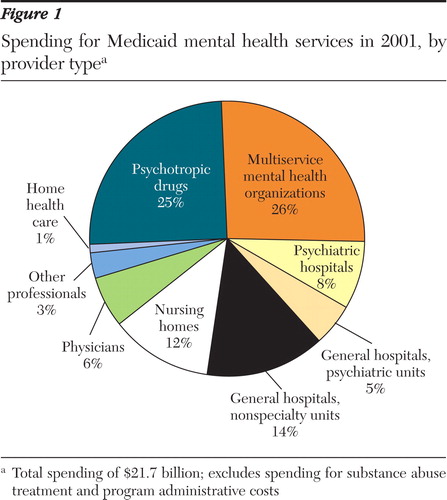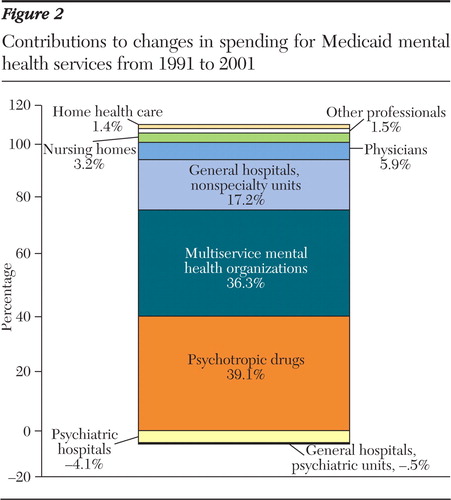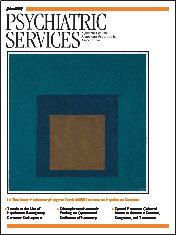Datapoints: Components of Spending for Medicaid Mental Health Services, 2001
Medicaid spending in 2001 for mental health services has been estimated to be $23.4 billion, representing about 27 percent of all mental health expenditures and 44 percent of all public mental health expenditures (1). This amount is larger than that from any other payer, including private insurance, Medicare, and all other state and local spending.
This column describes the distribution of expenditures for Medicaid mental health services by provider type. Details on the methods and databases used are described elsewhere by Mark and colleagues (1).
Figure 1 illustrates Medicaid spending in 2001 for mental health services by the type of provider, both specialty and general health care. In 1991 the spending level was $8.8 billion. From 1991 to 2001 the average annual rate of increase for Medicaid mental health expenditures was 9.4 percent. Figure 2 illustrates the relative contribution of each component of spending to the overall increase of $14.6 billion.
It is not surprising that these results showed that psychotropic drugs and multiservice mental health organizations were major components of such spending and accounted for a major proportion of the increase in such spending. However, the results also showed that nonspecialty providers of mental health care, particularly providers of nursing homes and general hospitals without psychiatric units, represent another significant component. The increasing share of spending going to such providers suggests that these services merit more attention in discussions of policies for public mental health services.
Acknowledgment
This research was supported by contract 270-01-7088 from the Substance Abuse and Mental Health Services Administration.
Dr. Mark is associate director of Medstat in Washington, D.C. Dr. Buck is associate director for organization and financing at the Center for Mental Health Services, 1 Choke Cherry Road, 6-1061, Rockville, Maryland 20857 ([email protected]). Harold Alan Pincus, M.D., and Terri L. Tanielian, M.A., are editors of this column.

Figure 1. Spending for Medicaid mental health services in 2001, by provider typea
a Total spending of $21.7 billion; excludes spending for substance abuse treatment and program administrative costs

Figure 2. Contributions to changes in spending for Medicaid mental health services from 1991 to 2001
1. Mark TL, Coffey RM, McKusick DR, et al: National Estimates of Expenditures for Mental Health Services and Substance Abuse Treatment, 1991–2001. SAMHSA pub no SMA 05–3999. Rockville, Md, Substance Abuse and Mental Health Services Administration, 2005Google Scholar



